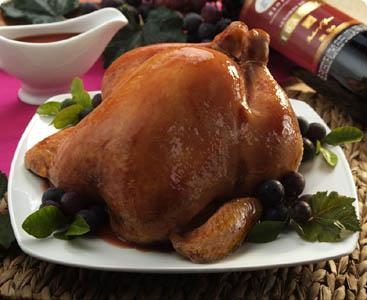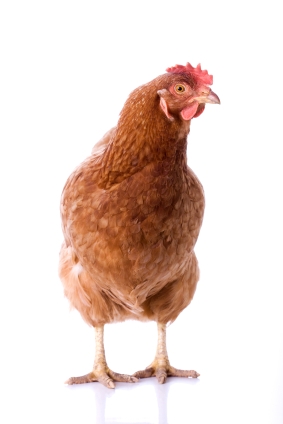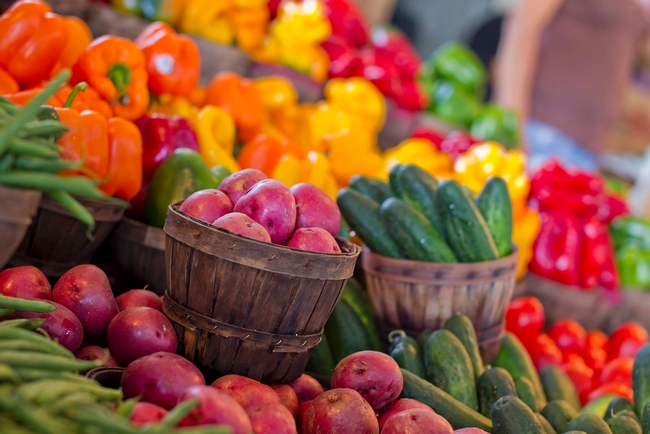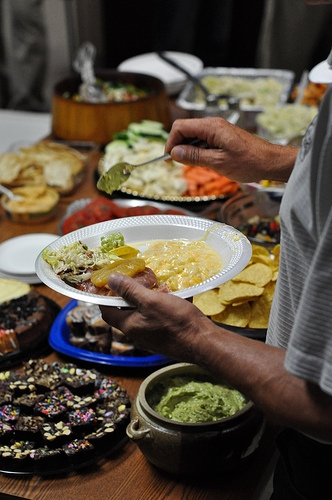Posts Tagged: foodborne illness
When salmonella outbreak hit, consumers responded
On October 7, 2013, the U.S. Department of Agriculture Food Safety and Inspection Service issued a Public Health Alert that linked Foster Farms chicken produced in three California facilities to illnesses caused by salmonella. Since then, according to the CDC website, Costco's El Camino Real store in South San Francisco has recalled over 23,000 units of rotisserie chicken products, and 25 ill individuals have been identified after eating products purchased at the Costco location. In California alone, 252 have reported illnesses linked to salmonella.
According to a study conducted by Chantal Toledo and Sofia Berto Villas-Boas in an ARE Update published by UC Davis' Giannini Foundation of Agricultural Economics, consumers tend to respond to food scares and government warnings. This is consistent with a Sacramento Bee report announcing a 25 percent decrease in the sale of Foster Farms chicken. The study also suggests that, in the case of an outbreak, consumers don't always switch to alternative brands. The 2010 egg recall resulted in an overall drop in egg sales because consumers did not switch to alternative egg brands. Although it is too early to determine a change in overall chicken sales, Julia Thomas at the Sacramento Natural Foods Coop has reported a 10 percent increase in chicken sales since the salmonella outbreak. According to Thomas, foodborne disease outbreaks are good for the organic food movement.
The UC Davis School of Veterinary Medicine is planning a series of experiments to better understand Salmonella Heidelberg, the strain of salmonella found in Foster Farms Chicken, which has been a problem for the poultry industry in California and has been associated with human outbreaks since last year. Using molecular techniques, the experiments will study gene expression and determine a better characterization of the strains involved in the outbreak.
The School of Veterinary Medicine is also collaborating with the Animal Science Department at UC Davis and UC Cooperative Extension to leverage DNA sequencing in order to better understand the virulence of Salmonella Heidelberg and it's potential to cause disease under processing conditions.
Concerned about your own chickens? "The CAHFS Lab System routinely provides diagnostic support for commercial, small flock and backyard poultry producers in California," says Richard Breitmeyer, director of the the California Animal Health and Food Safety (CAHFS) Lab System at the UC Davis School of Veterinary Medicine, "including testing for salmonella." More information can be found on their website.
Foodborne Disease Outbreaks and Consumer Purchases

Roasted chicken. (Photo: Wikimedia Commons)
What's in your compost?
For home gardeners, spring is a busy time of year and there’s never a tomato with more flavor than one grown to full ripeness on the vine. But there are also many safety precautions to follow to prevent contamination of fruits and vegetables with pathogens that cause serious food-borne illnesses.
Michele Jay-Russell, a veterinarian and research microbiologist at the Western Institute for Food Safety and Security (WIFSS) and program manager of the Western Center for Food Safety (WCFS), recently co-authored a study that highlights the need to be aware of the hazards associated with using raw animal manure to fertilize home gardens. (Read full article here.)
The basis for the study began in July of 2010 when a shire mare from a rural Northern California farm was brought to the William R. Pritchard Veterinary Medical Teaching Hospital for treatment of colic. Following protocol, the veterinarians on call screened the horse for Salmonella to avoid infecting other horses during hospitalization. She tested positive and after successful treatment for colic, went home. Her owners then notified the veterinarians that some of their other draft horses were sick as well — all 8 were tested and 6 came back positive for the same Salmonella Oranienburg strain, including the mare that still had the infection.
Jay-Russell heard about the case from her colleague John Madigan, professor of medicine and epidemiology at the school. The farm’s owners invited Jay-Russell and Madigan to the farm to see if they could uncover the source of the Salmonella infection. They sampled water from horse troughs, manure storage piles, wild turkey feces and soil from the family’s edible home garden where raw horse manure had been used as fertilizer. Each of those locations had a percentage of positive samples over the sampling period from August 2010 to March 2011.
“We showed the owners how to continue collecting samples and provided them with a FedEx number to ship them to UC Davis,” Jay-Russell said. “During that whole time, the garden soil kept coming back positive, which showed that this strain of Salmonella could persist for months.”
While the researchers couldn’t be completely certain about the original source of Salmonella on the farm, they suspect that a recent surge in the wild turkey population on the property introduced the bacteria to the horses by pooping in the horse corrals and in the water troughs. They speculated that the wild turkeys brought the Salmonella onto the property, although they couldn’t rule out the possibility that the birds were exposed on the farm or to other potential sources of Salmonella.
“What is clearer is that the raw horse manure applied as fertilizer was the most likely source of garden soil contamination,” Jay-Russell explained. “We suspect that the damp climate in Mendocino County may have contributed to the longevity of this bacterium in the soil long after the owners stopped applying the horse manure to the garden. Fortunately, the owners didn’t get sick, but our investigation showed the potential for widespread dissemination of Salmonella in a farm environment following equine infection.”
To promote safe gardening practices, Jay-Russell has teamed with Trevor Suslow, a Cooperative Extension food safety specialist in the Department of Plant Sciences, to speak to groups of small farmers around the state about best practices. They also use a brochure in English and Spanish, “Food Safety Tips for Your Edible Home Garden,” that includes information about safe uses of animal manure and ways to minimize animal fecal contamination.
“It’s good to let people know about the risks and to correct misinformation about ways to treat the compost pile before using it in the garden,” Jay-Russell said. “The biggest take home message from this experience is to be very careful about using manure from sick horses — and to be cautious about offers of free manure — you don’t know what’s in there. Commercial compost should be bought from a reputable source.”
She urges gardeners to take a class and learn how to compost correctly and safely. Each county in California has UC Cooperative Extension advisors and many have Master Gardener programs offering information on food safety.
Additional resources:
Chicken salad recall put the spotlight on mysterious food pathogen, Listeria monocytogenes
The news this past week that nearly three tons of Trader Joe’s prepared barbeque chicken salad were recalled due to possible contamination by Listeria moncytogenes had me wondering anew about this mysterious foodborne pathogen. And today, seven tons of Garden Fresh prepared salads were also recalled.
I’ve spent precious minutes worrying about E. coli (ubiquitous, especially in poop) and Salmonella (the reason we must take care with raw eggs), but why doesn’t Listeria moncytogenes rank higher on my food-safety recognition meter?
A quick check of the U.S. Food and Drug Administration website showed that of 27 food recalls in July, 16 were related to Listeria monocytogenes. (One was linked to Staph bacteria, three to Salmonella and the rest to undeclared ingredients.)
Susan Algert, UC Cooperative Extension advisor in Santa Clara County, helped to fill me in. She is a nutrition, family and consumer sciences expert. Listeria monocytogenes is a ubiquitous soilborne bacteria found virtually everywhere.
The problem arises, Algert said, when the bacteria is spread by food handlers, farm equipment and food processing machines, then allowed to grow to levels that can cause illness.
“It can proliferate in the refrigerator if it’s not cold enough, under 40 °F,” Algert said, “and it will not be killed if food isn’t heated to over 140 °F.”
Safe food handling is key to preventing listeriosis, and all other foodborne illnesses, in people at greatest risk. This includes:
- Washing hands before preparing food.
- Thawing foods in the refrigerator — never at room temperature.
- Keeping foods cold (< 40 °F) or heating them thoroughly (> 140 °F).
- Disposing of perishable foods that have been left out for more than an hour.
“These measures are especially important at this time of year,” Algert said. “It’s warm. Dangerous bacteria in food will grow faster.”
(ANR has published guidelines for controlling Listeria monocytogenes in food packing operations.)
Algert noted that the symptoms of listeriosis can occur long after exposure, another reason why illnesses may not be linked to the bacteria.
“The incubation period is up to 70 days,” she said. “Many people get sick but don’t associate it with something they ate several weeks ago.”
While it was the chicken salad recall that hit the news, the recall actually involved all onions processed by Gill’s Onions of Oxnard, which supplies onions for processed salads and other foods. Other California products affected by the recall included Trader Joe’s salad dressings, butternut squash salad, and red quinoa and wheatberry salad. The Garden Fresh prepared salads also contained these onions.
The products were voluntarily recalled after FDA found Listeria monocytogenes in a random sample of diced yellow onions; the factory has been closed since July 17 pending an investigation. No illnesses have been linked to the possibly contaminated products.
“Gills Onions is committed to protecting public health and to executing this voluntary recall effectively and efficiently,” said Steve Gill, president of the company. “We are a multigenerational family business, and we work hard every day to earn the trust and confidence of customers and consumers who enjoy our high quality, healthy products.”
Anyone who has the recalled product should not consume it and destroy or discard it. Trader Joe’s said that it will provide full refunds.
Foodborne illnesses and the 100K Genome Project
An ambitious effort to sequence the genomes of 100,000 infectious microorganisms and speed diagnosis of foodborne illnesses has been launched by the University of California, Davis, Agilent Technologies, and the U.S. Food and Drug Administration.
Bart Weimer, professor in the UC Davis School of Veterinary Medicine, serves as director of the 100K Genome Project and co-director of the recently established BGI@UC Davis facility, where the sequencing will be done. Other collaborators include the U.S. Centers for Disease Control and Prevention and the U.S. Department of Agriculture.
The new five-year microbial pathogen project focuses on making the food supply safer for consumers. The group will build a free, public database including sequence information for each pathogen's genome — the complete collection of its hereditary information. The database will contain the genomes of important foodborne pathogens including Salmonella, Listeria, and E. coli, as well as the most common foodborne and waterborne viruses that sicken people and animals.
The project will provide a roadmap for developing tests to identify pathogens and help trace their origins more quickly. The new genome database also will enable scientists to make discoveries that can be used to develop new methods for controlling disease-causing bacteria in the food chain.
"This landmark project will revolutionize our basic understanding of these disease-causing microorganisms," said Harris Lewin, vice chancellor for research at UC Davis.
The sequencing project is critically important for tackling the continuing outbreaks of often-deadly foodborne diseases around the world. In the United States alone, foodborne diseases annually sicken 48 million people and kill 3,000, according to the CDC.
"The lack of information about food-related bacterial genomes is hindering the research community's ability to improve the safety and security of the world food supply," Weimer said. "The data provided by the 100K Genome Project will make diagnostic tests quicker, more reliable, more accurate and more cost-effective."
"We see this project as a way to improve quality of life for a great many people, while minimizing a major business risk for food producers and distributors," said Mike McMullen, president of Agilent’s Chemical Analysis Group.
A consumer-focused article about the project is available on the FDA website.
(This article was condensed from a UC Davis news release. Read the full press release and watch a video of Bart Weimer giving an overview of the project.)
Have a happy, healthy July 4 celebration
For as long as I can remember, Independence Day has not been about being alone and independent, the Fourth of July is traditionally spent with family and friends, barbecuing, overeating and watching fireworks. Come to think of it, aren’t all American holidays celebrated with abundant quantities of food? And those mass quantities of food tend to be set out on July 4 and left within easy reach for hours.
It’s a wonder July 5th isn’t national foodborne illness day. According to UC food safety experts, food left at room temperature for two hours can become unsafe to eat. If left out in summer heat above 90 degrees, bacteria get busy and can grow to unsafe levels in food in one hour.
UC Cooperative Extension has a handout online called “The Lunch Box,” which contains tips for making school lunches that don’t deliver foodborne illness. A lot of those tips apply to picnics as well, such as “Keep hot things hot and cold things cold.”
The main foods The Lunch Box recommends be kept cold (40 degrees F or lower) are meat, poultry, fish, eggs, milk, soft cheese and pasta salad, which usually contains mayo. Peeled or cut fruits and vegetables should also be kept cold to deter bacteria growth. Chili, casseroles and refried or baked beans should either be piping hot or chilled. Foodsafety.gov has details for properly preparing, serving and storing various foods.
Brenda Roche Wolford, UC Cooperative Extension advisor in Los Angeles County, specializes in nutrition, family and consumer sciences and pointed me to the Partnership for Food Safety Education website. The partnership recommends four food handling steps to prevent you and your family from suffering foodborne illness and Brenda adds a fifth step:
- Clean
- Cook
- Separate
- Chill
Bonus step: Throw it away
Yes, we must be told explicitly to throw away contaminated food. Most Americans have been told since childhood that we shouldn’t waste food because children in a country that we haven’t visited are starving. I feel the guilt too. Yet, I’d rather chuck suspect food than to be upchucking it later. Those are my words, not Brenda’s. She uses much more professional terms like nausea.
UC ANR has created the “Make it Safe, Keep it Safe” training for employees and volunteers, but it has useful information that anyone can use. The U.S. Food and Drug Administration also has tips for handling food safely when eating outdoors, such as “don’t cross-contaminate.” See the UC Food Safety website for all kinds of food safety information, including publications in Spanish. And if you need some tunes for your party, visit the UC Food Safety Music website to hear “Don’t Get Sicky Wit It,” “Stomachache Tonight,” “We are the Microbes” and many more.
May you have a happy and healthy Independence Day!






